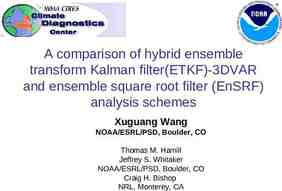Fourier Analysis Lecture-8 Additional chapters of mathematics
21 Slides1.17 MB

Fourier Analysis Lecture-8 Additional chapters of mathematics Dmitriy Sergeevich Nikitin Assistant Tomsk Polytechnic University email: [email protected] 1

Fourier Analysis The central starting point of Fourier analysis is Fourier series. They are infinite series designed to represent general periodic functions in terms of simple ones, namely, cosines and sines. This trigonometric system is orthogonal, allowing the computation of the coefficients of the Fourier series by use of the well-known Euler formulas. Fourier series are very important to the engineer and physicist because they allow the solution of differential equations in connection with forced oscillations and the approximation of periodic functions. 2

Fourier Analysis The underlying idea of the Fourier series can be extended in two important ways. We can replace the trigonometric system by other families of orthogonal functions, e.g., Bessel functions and obtain the Sturm–Liouville expansions. The second expansion is applying Fourier series to nonperiodic phenomena and obtaining Fourier integrals and Fourier transforms. Both extensions have important applications to solving differential equations. In a digital age, the discrete Fourier transform plays an important role. Signals, such as voice or music, are sampled and analyzed for frequencies. An important algorithm, in this context, is the fast Fourier transform. 3

Fourier Series A function f(x) is called a periodic function if f(x) is defined for all real x, except possibly at some points, and if there is some positive number p, called a period of f(x), such that f(x p) f(x) (and also f (x np) f (x)) The graph of a periodic function has the characteristic that it can be obtained by periodic repetition of its graph in any interval of length p. The smallest positive period is often called the fundamental period. 4

Fourier Series Our problem will be the representation of various functions of period in terms of the simple functions 1 cos x sin x cos 2x, sin 2x, , cos nx, sin nx, . All these functions have the period 2π. They form the socalled trigonometric system. The series to be obtained will be a trigonometric series, that is, a series of the form are constants, called the coefficients of the series. We see that each term has the period 2π. Hence if the coefficients are such that the series converges, its sum will be a function of period 2π. 5

Fourier Series Now suppose that f(x) is a given function of period 2π and is such that it can be represented by a series (1), that is, (1) converges and, moreover, has the sum f(x). Then, using the equality sign, we write and call this formula the Fourier series of f(x). The coefficients are the so-called Fourier coefficients of f(x), given by the Euler formulas 6

Fourier series (examples) 7

From Period 2π to Any Period p 2L Clearly, periodic functions in applications may have any period, not just 2π as in the last section (chosen to have simple formulas). The transition from period to be period p 2L is effected by a suitable change of scale, as follows. Let f(x) have period. Then, using the equality sign, we write with the Fourier coefficients of f(x) given by the Euler formulas 8

From Period 2π to Any Period p 2L If is an even function, that is, f(-x) f(x), its Fourier series reduces to a Fourier cosine series with the Fourier coefficients If is an odd function, that is, f(-x) -f(x), its Fourier series reduces to a Fourier sine series with the Fourier coefficients 9

Sum and Scalar Multiple THEOREM1 The Fourier coefficients of a sum f1 f2 are the sums of the corresponding Fourier coefficients of f1 and f2. The Fourier coefficients of cf are c times the corresponding Fourier coefficients of f. 10

Orthogonal systems The idea of the Fourier series was to represent general periodic functions in terms of cosines and sines. The latter formed a trigonometric system. This trigonometric system has the desirable property of orthogonality which allows us to compute the coefficient of the Fourier series by the Euler formulas. The question then arises, can this approach be generalized? That is, can we replace the trigonometric system by other orthogonal systems (sets of other orthogonal functions)? The answer is “yes” and leads to generalized Fourier series, including the Fourier-Legendre series and the Fourier-Bessel series. 11

Orthogonal functions Functions y1(x), y2(x), defined on some interval are called orthogonal on this interval with respect to the weight function r(x) 0 if for all m and all n different from m, is a standard notation for this integral. The norm of is defined by 12

Orthogonal series Fourier series are made up of the trigonometric system, which is orthogonal, and orthogonality was essential in obtaining the Euler formulas for the Fourier coefficients. Orthogonality will also give us coefficient formulas for the desired generalized Fourier series, including the Fourier–Legendre series and the Fourier–Bessel series. This generalization is as follows. Let y0, y1, y2, be orthogonal with respect to a weight function r(x) on an interval , and let f(x) be a function that can be represented by a convergent series This is called an orthogonal series, orthogonal expansion, or generalized Fourier series. 13

Orthogonal systems Given f(x), we have to determine the coefficients , called the Fourier constants of f(x) with respect to y0, y1, y2, 14

Fourier Integral Fourier series are powerful tools for problems involving functions that are periodic or are of interest on a finite interval only. Since, of course, many problems involve functions that are nonperiodic and are of interest on the whole x-axis, we ask what can be done to extend the method of Fourier series to such functions. This idea will lead to Fourier integrals. The main application of Fourier integrals is in solving ODEs (Ordinary differential equations) and PDEs (Partial differential equations). 15

Fourier Integral We now consider any periodic function fL(x) of period 2L that can be represented by a Fourier series and find out what happens if we let L . We should expect an integral (instead of a series) involving cos wx and sin wx with w no longer restricted to integer multiples w wn nπ/L of π/L but taking all values. 16

Fourier Integral After some transformations we get where This is called a representation of f(x) by a Fourier integral. 17

Fourier Integral Sufficient conditions for the validity of a formula for Fourier integral are as follows THEOREM1 If f(x) is piecewise continuous in every finite interval and has a right-hand derivative and a left-hand derivative at every point and if the integral exists, then f(x) can be represented by a Fourier integral with A and B given by the above formulas. At a point where f(x) is discontinuous the value of the Fourier integral equals the average of the left- and right-hand limits of f(x) at that point. 18

Fourier Integral Just as Fourier series simplify if a function is even or odd, so do Fourier integrals. Indeed, if f has a Fourier integral representation and is even, then B(w) 0. This holds because the integrand of B(w) is odd. Then f(x) reduces to a Fourier cosine integral Similarly, if f has a Fourier integral representation and is odd, then A(w) 0. This is true because the integrand of is odd. Then f(x) becomes a Fourier sine integral 19

Fourier Integral Just as Fourier series simplify if a function is even or odd, so do Fourier integrals. Indeed, if f has a Fourier integral representation and is even, then B(w) 0. This holds because the integrand of B(w) is odd. Then f(x) reduces to a Fourier cosine integral Similarly, if f has a Fourier integral representation and is odd, then A(w) 0. This is true because the integrand of is odd. Then f(x) becomes a Fourier sine integral 20

END OF LECTURE-7 21






